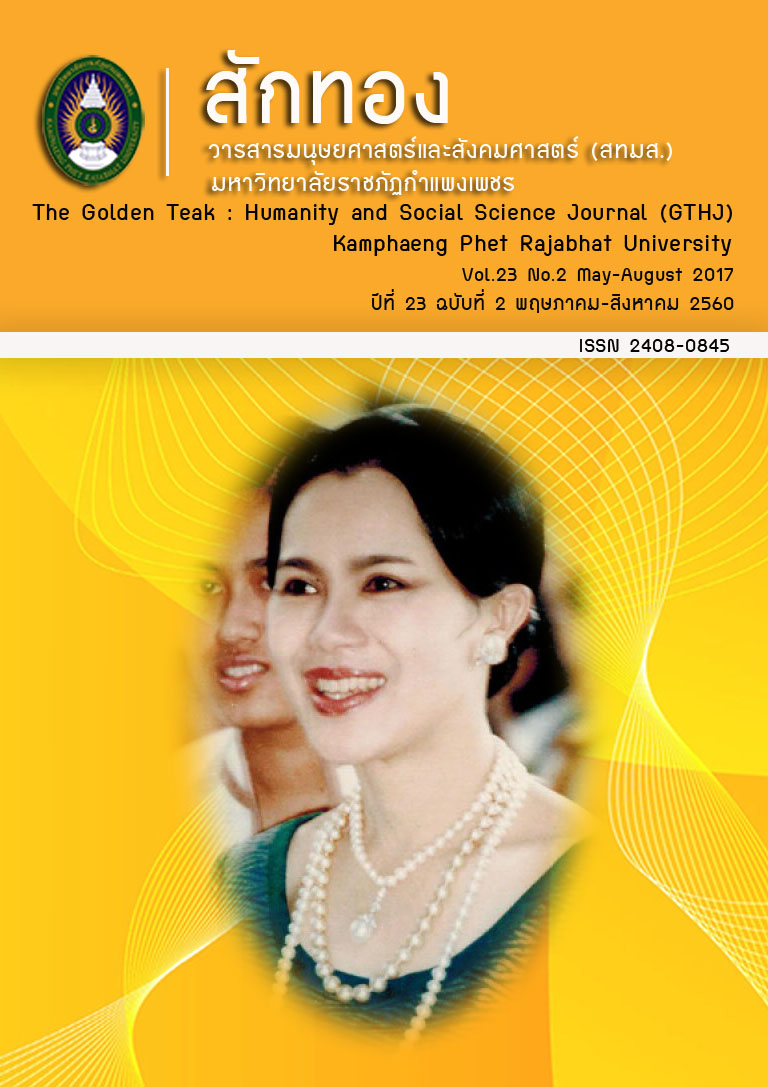การพัฒนารูปแบบการป้องกันการกลับไปเสพซ้ำ ของผู้ที่เข้ารับการบำบัดรักษาสารเสพติด ในสถานบริการสาธารณสุข จังหวัดตาก
Main Article Content
Abstract
บทคัดย่อ
การวิจัยนี้มีวัตถุประสงค์เพื่อพัฒนารูปแบบการป้องกันการกลับไปเสพซ้ำของผู้ที่เข้ารับการบำบัดรักษาสารเสพติดในสถานบริการสาธารณสุขจังหวัดตาก วิธีดำเนินการวิจัยแบ่งเป็น 4 ขั้นตอนตามวัตถุประสงค์ของการวิจัย รวบรวมข้อมูล โดยการศึกษาเชิงเอกสาร การประชุมอภิปรายกลุ่ม การศึกษาข้อมูลย้อนหลัง การประชุมเชิงปฏิบัติการ การใช้แบบ ประเมินรูปแบบการป้องกันการกลับไปเสพซ้ำ โดยเก็บรวบรวมข้อมูล จากผู้รับผิดชอบงานสารเสพติดระดับจังหวัด อำเภอ โรงพยาบาล และโรงพยาบาลส่งเสริมสุขภาพตำบล ผู้ทรงคุณวุฒิจากสหวิชาชีพ วิเคราะห์ข้อมูลโดย ค่าร้อยละ ค่าเฉลี่ย ค่าส่วนเบี่ยงเบนมาตรฐาน การทดสอบ Chi-square test ในการเปรียบเทียบสัดส่วนของข้อมูลระหว่างกลุ่ม โดยกำหนด ค่านัยสำคัญทางสถิติที่ระดับ 0.05 และการวิเคราะห์เนื้อหา ผลการวิจัยพบว่า รูปแบบการป้องกันการกลับไปเสพซ้ำ ของผู้ที่เข้ารับการบำบัดรักษาสารเสพติดในสถานบริการสาธารณสุข จังหวัดตากประกอบด้วย ด้านการวางแผน:การเพิ่ม ศักยภาพผู้รับผิดชอบงานสารเสพติด การศึกษาบริบท ส่งเสริมให้ความรู้ การเลือกโปรแกรมการบำบัดให้เหมาะสมกับผู้เข้ารับการบำบัด มีการกำหนดโครงสร้างและกำหนดบทบาทหน้าที่ชัดเจน จัดหาชุดตรวจสารเสพติด/วัสดุอุปกรณ์ในการทำ ค่ายบำบัดให้เพียงพอ ด้านการดำเนินงาน: การคัดกรองผู้เข้ารับการบำบัด การดำเนินการบำบัดรักษาตามโปรแกรม สร้างแรงจูงใจให้อยู่ในระบบการบำบัด สร้างการยอมรับของครอบครัวและมีส่วนร่วมในการบำบัด และสร้างแรงจูงใจให้กับ ผู้เข้ารับการบำบัดที่เป็นรูปธรรม ด้านการตรวจสอบผล/ประเมินผล: ตรวจสอบความถูกต้องของการคัดกรองเบื้องต้น สร้างกลุ่มเพื่อนช่วยเพื่อนในการติดตามผู้เข้ารับการบำบัด สอบถามความพึงพอใจของครอบครัวและชุมชนต่อผลของ การบำบัดสารเสพติด และประเมินอัตราการคงอยู่ในการบำบัดรักษา ด้านการปรับปรุง: การนำผู้เข้ารับบำบัดที่เลิกได้มาเป็น บุคคลต้นแบบ การส่งเสริมสนับสนุน การตั้งชมรมคนเลิกสารเสพติด ผลการประเมินความเหมาะสมของรูปแบบโดยภาพ รวมพบว่ารูปแบบที่พัฒนาขึ้นมีความเหมาะสมอยู่ในระดับมาก และเมื่อเปรียบเทียบผลการนำรูปแบบไปใช้ พบว่าการกลับไปเสพซ้ำลดลงจากร้อยละ 33.9 ก่อนการพัฒนารูปแบบ เหลือร้อยละ 27.1 หลังการพัฒนารูปแบบ อย่างมีนัยสำคัญทางสถิติ (p< 0.01)
Model Development for Relapse Prevention After Treatment Among Substance Abusers in Tak Province
ABSTRACT
The general purpose of this research was to develop a model for relapse prevention after treatment among substance abusers in health care centers in Tak province. The research had 4 specific objectives. The study methods corresponding with specific objectives included document reviews, focus group discussions, analysis of retrospective study data, workshops, and use of evaluation forms to assess the relapse prevention model. The data were collected from health personnel responsible for management programs of substance use at the provincial, district, and sub district levels, and also from the health experts about addictive substance. The data were analyzed using percentage, mean, standard deviation, chi-square test with a significant level of 0.05, and content analysis. The model for relapse prevention after treatment among substance abusers in Tak province had four components. The First, planning included increasing competency of personnel responsible for management of substance use, context study, promoting awareness, and choosing a treatment program appropriate for substance abusers. Second, operation included screening target persons for treatment, implementing a treatment program, motivation for maintaining a treatment program, and increasing acceptance of and participation in family members. Third, monitoring/evaluation included checking the validity of initial screening, creating a peer group to help follow-up addictive substance abusers, determining satisfaction of treatment among their family and community, and assessing retention rates of treatment. Last, improvement included using a person with no relapse after treatment as a good role model and promoting the club of persons who can quit drugs. The guidelines were appropriate, feasible and useful at the high level. The proportion of substance abusers with repeated treatment significantly (p< 0.01) reduced from 33.9% before the model development to 27.1 after the model development.
Article Details
บทความที่ได้รับการตีพิมพ์เป็นลิขสิทธิ์ของวารสาร สักทอง : วารสารมนุษยศาสตร์และสังคมศาสตร์ สถาบันวิจัยและพัฒนา มหาวิทยาลับราชภัฏกำแพงเพชร
ข้อคิดเห็นใดๆ ที่ปรากฎในวารสารเป็นวรรณกรรมของผู้เขียนโดยเฉพาะ ซึ่งมหาวิทยาลัยราชภัฏกำแพงเพชรและบรรณาธิการไม่จำเป็นต้องเห็นด้วย


